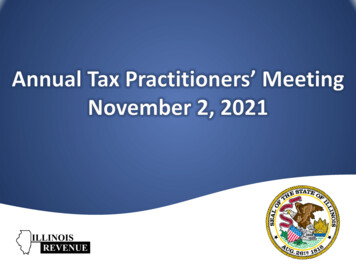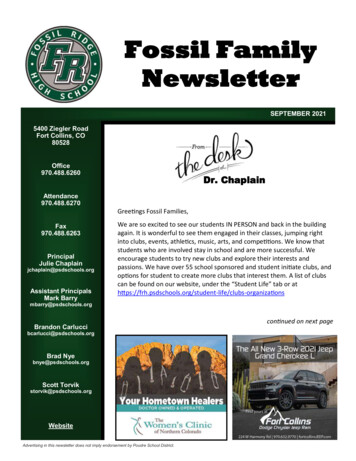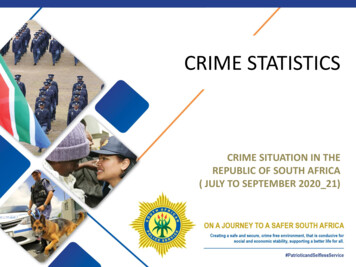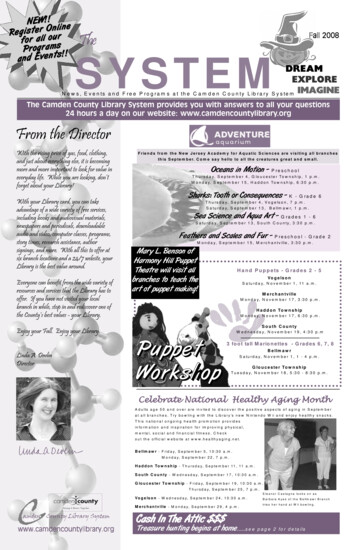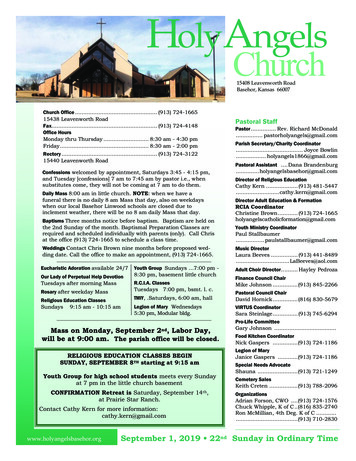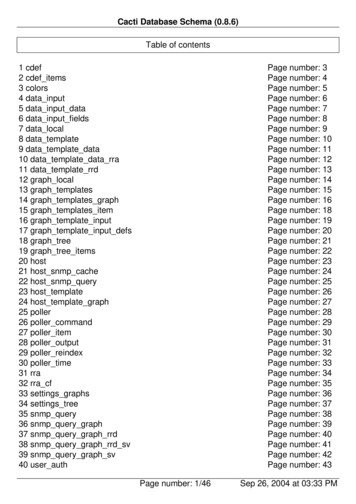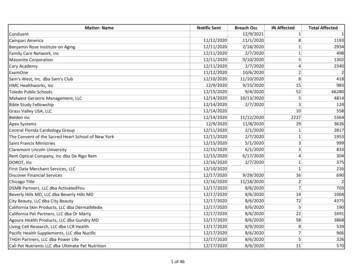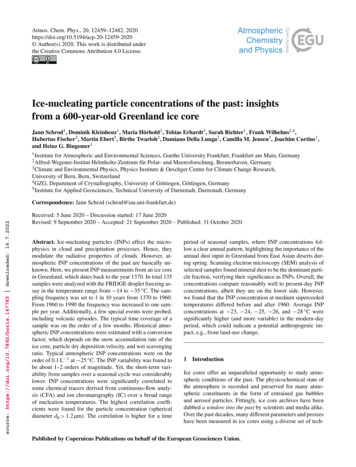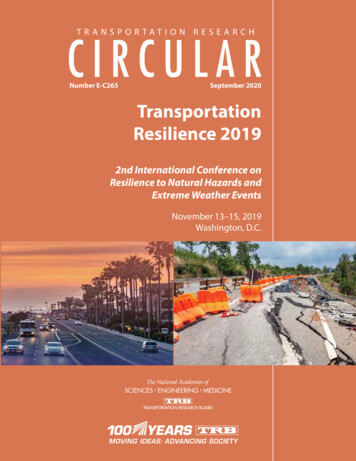
Transcription
TRANSPORTATION RESEARCHNumber E-C265September 2020TransportationResilience 20192nd International Conference onResilience to Natural Hazards andExtreme Weather EventsNovember 13–15, 2019Washington, D.C.
TRANSPORTATION RESEARCH BOARD2020 EXECUTIVE COMMITTEE OFFICERSChair: Carlos M. Braceras, Executive Director, Utah Department of Transportation, SaltLake CityVice Chair: Susan A. Shaheen, Adjunct Professor, Co-Director, TransportationSustainability Research Center, University of California, BerkeleyDivision Chair for NRC Oversight: Chris Hendrickson, Hamerschlag UniversityProfessor Emeritus, Carnegie Mellon University, Pittsburgh, PennsylvaniaExecutive Director: Neil J. Pedersen, Transportation Research BoardTRANSPORTATION RESEARCH BOARD2020–2021 TECHNICAL ACTIVITIES COUNCILChair: Hyun-A C. Park, President, Spy Pond Partners, LLC, Arlington, MassachusettsTechnical Activities Director: Ann M. Brach, Transportation Research BoardRichard Bornhorst, Principal, FACTOR, Inc., Silver Spring, Maryland, Freight SystemsGroup ChairMichael Griffith, Director, Office of Safety Technologies, Federal Highway Administration,Washington, D.C., Safety and Operations Group ChairGeorge Avery Grimes, CEO Advisor, Patriot Rail Company, Denver, Colorado, Rail GroupChairBrendon Hemily, Principal, Hemily and Associates, Toronto, Ontario, PublicTransportation Group ChairNikola Ivanov, Deputy Director, Center for Advanced Transportation TechnologyLaboratory, University of Maryland, College Park, Young Members Council ChairPamela Keidel-Adams, Regional Vice President, Kimley-Horn and Associates, Inc., Mesa,Arizona, Aviation Group ChairC. James Kruse, Director, Center for Ports and Waterways, Houston, Texas, Marine GroupChairJane Lin, Professor, University of Illinois, Chicago, Sustainability and Resilience GroupChairMark Reno, Principal Engineer, Quincy Engineering, Inc., Rancho Cordova, California,Highway Infrastructure Group ChairElizabeth Rushley, Lawhon & Associates, Inc., Columbus, Ohio, Data, Planning, andAnalysis Group ChairFred R. Wagner, Partner, Venable, LLP, Washington, D.C., Legal Resources Group ChairKathryn Zimmerman, Applied Pavement Technology, Inc., Urbana, Illinois, Policy andOrganization Group Chair
TRANSPORTATION RESEARCH CIRCULAR E-C265Transportation Resilience 20192nd International Conference on Resilience toNatural Hazards and Extreme Weather EventsNovember 13–15, 2019Washington, D.C.Hosted byTransportation Research BoardWith support fromFederal Highway AdministrationAmerican Association of State Highway Transportation OfficialsOrganized bySpecial Task Force on Climate ChangeRapporteursAimee FlanneryCharles MoserJessica WalkerDevon BurtonAEM CorporationTransportation Research Board500 Fifth Street, NWWashington, D.C.www.trb.org
TRANSPORTATION RESEARCH CIRCULAR E-C265ISSN 0097-8515The Transportation Research Board is one of seven major programs of the National Academies of Sciences,Engineering, and Medicine. The mission of the Transportation Research Board is to provide leadership intransportation improvements and innovation through trusted, timely, impartial, and evidence-based informationexchange, research, and advice regarding all modes of transportationThe Transportation Research Board is distributing this E-Circular to make the information contained hereinavailable for use by individual practitioners in state and local transportation agencies, researchers in academicinstitutions, and other members of the transportation research community. The information in this E-Circular wastaken directly from the submission of the authors. This document is not a report of the National Academies ofSciences, Engineering, and Medicine.Conference Planning CommitteeMichael Culp, Federal Highway Administration (Co-Chair)Kees van Muiswinkel, Rijkswaterstaat, The Netherlands (Co-Chair)Carol Lee Roalkvam, Washington State Department of Transportation (Co-Chair)Mark Abkowitz, Vanderbilt University, Chair of the TRB Special Task Force on Climate ChangeJeff Arnold, U.S. Army Corps of EngineersVicki Arroyo, Georgetown Climate CenterAnnie Bennett, Georgetown Climate CenterThomas Bles, DeltaresClaire Bonham-Carter, AECOMAnne Choate, ICF InternationalDave Claman, Iowa Department of TransportationJosh DeFlorio, Port Authority of New York and New JerseySusanne DesRoches, New York City Mayor’s Office of Recovery and ResilienceBrenda Dix, ICF InternationalScott Douglass, University of South AlabamaTracey Frost, CALTRANSJulia Gold, Rhode Island Department of TransportationRobert Graff, Delaware Valley Regional Planning CommissionElizabeth Habic, Maryland State Highway Administration, Maryland Department of TransportationPaula Hammond, WSPJennifer Jacobs, University of New HampshireTom Jacobs, Mid-America Regional CouncilConstantine Samaras, Carnegie Mellon UniversityMelissa Savage, American Association of State Highway and Transportation OfficialsFederal Highway Administration LiaisonsBrian Beucler,Heather HolsingerRobert KafalenosRebecca LupesTRB StaffWilliam Anderson, Senior Program OfficerGary Jenkins, Associate Program OfficerTransportation Research Board500 Fifth Street, NWWashington, D.C.www.trb.org
ContentsPreface. 1Opening and Welcome Remarks . 3Prioritizing Resilience at State Departments of Transportation:Progress and Challenges . 7Integrating Transportation Resilience into Asset Management . 14Integrating Extreme Weather Risks into Transportation AssetManagement Plans and Practices . 14Prioritizing Infrastructure Resilience Throughout the TransportationCapital Planning Process. 15Southeast Michigan Flooding Study: Assessing Risk and Building Resilience . 17Maximizing the Resiliency from Your Capital Spend: AnalysisTools to Address Resiliency Goals Management . 18Development and Incorporation of Quantitative Risk and ResilienceAnalysis Standards into Agency Decision-Making . 20Regional and Multisectoral Scale Approaches to Resilience . 22Opportunities for Dynamic Adaptation . 22Safeguarding Assets When You Can’t Get There from Here:Shared Challenges in the Nexus of Multimodal Surface Transport,Buildings and Mission . 23Enhancing Local Climate Resilience with State Level Transportation Risk . 25Bridges and Culverts: Assessment of Resilience for Planning . 27Resilient Bridge Planning in Mozambique: Bridge Failure Riskfrom Flooding and Climate Change. . 27Evaluating the Performance and Resilience of Major StormwaterInfrastructure Systems Under Climate Change and Land Use Certainty . 29Culvert Resilience Assessment: from Pilot to Practice . 31State of Play of Proactive Adaptation: Focus-Point Session . 33Frameworks and Methods to Address Coastal Resilience, Part A. 37Highways in the Coastal Environment: A U.S. Engineering Manual . 37Strategies to Increase Resilience of Florida DOT’s Facilities . 39A Stepwise and Flexible Adaptation Framework for Coastal RoadInfrastructure Resilience to a Changing Climate . 42A Framework for Selecting Sea-Level Rise for the Design ofResilient Infrastructure. 45Transforming Design for Resilience, Part A. 47Flood Resiliency: The Added Benefit of Aquatic Organism PassageUsing the Stream Simulation Design Methodology . 47Improving Resiliency and Sustainability of Vulnerable Infrastructureby Using Natural Stream Channel Design and Restoration: Three Case Studies . 48Approaches to Addressing Multiple Hazards Within a LargerMultimodal Program . 50Arizona DOT: Designing, Funding, and Building Resilience into a 1-Billion Construction Program. 50iv
Assessment of Incorporating Climate Adaptation into a State DOT:Caltrans Experience . 51Development of a Concept for Resilience Management for FederalHighways in Germany . 52Colorado’s Road to Resiliency . 53Flood-Resilient Critical Infrastructure: Dutch Policy and the Roleof the National Highway Network . 54Integrating Resilience in Transportation Planning, Part A . 56Transportation Planning, Cultural Resources Management, and Climate Resilience. 56Transforming Design for Resilience, Part B . 58Port Decision Makers’ Barriers to Climate and Extreme Weather Adaptation . 58Supporting Stormwater Infrastructure Decisions Under UncertaintyThrough a Spatial and Temporal Analysis of Engineering Standards . 59Addressing Infrastructure Resilience at Road–River IntersectionsUsing the Geomorphic Approach . 60Projections and Downscaling: Developing and Applying Precipitation andTemperature Projections, Part 1 . 62Risk Assessment and Resiliency for Design Rainfall . 62Breaking the Mold: Changing the Practice of Processing ClimateProjections for Transportation Planning . 64Informing Neighborhood-Scale Decisions: Advances inClimate Impact Downscaling . 64NCHRP Project 15-61, “Applying Climate Change Information toHydrologic and Hydraulic Design of Transportation Infrastructure” . 65Innovative Collaboration for Resilience to Extreme Weather Events . 68Collaborating for Transportation Resilience and Recovery in thePortland–Vancouver Region . 68Working Toward Resilient Transportation in the Tampa Bay Region . 69Collaborative Efforts Toward Increased Agency Resiliency . 70Innovations from Partnerships in Research and Practice . 71Economic Analysis to Support Resilience, Part A. 72Reaping the Benefits of Resilient Design to ReduceProperty Insurance Premiums . 72Resilience Economics at the Facility and Program Scales . 73NCHRP Project 20-101, “Guidelines to Incorporate the Costs and Benefits of AdaptationMeasures in Preparation for Extreme Weather Events and Climate Change”. 74Nature-Based Solutions for Coastal Highway Resilience . 76Nature-Based Solutions for Coastal Highway Resilience: Engineering,Ecology, and Practitioner Perspectives . 76Research and Pilot Projects Under the USACE Engineering with Nature Initiative . 77the Ecological Effects of the Sea-Level Rise Program . 78Geotechnical Aspects in Transportation Resilience . 80GIS Model for Landslide Susceptibility Due to High-Precipitation Rainstorm . 80Geohazards, Extreme Weather Events, and Climate Resilience:the Development of FHWA Guidance . 82v
Case Study: Maryland Rockfall Investigation and Back Analysis . 83Resilience System to Natural Hazards In Norwegian Public Roads Administration . 85Causality and Surrogates: Bridge Vulnerability and Resilience . 88Impacts of Flood Change on Bridge Scour Reliability . 88Scour and Resilience: Focusing on the Issues . 89Detection, Attribution, and Adjustment for Flood Change Across the United States . 90Development of Site-Specific Hydrologic and Hydraulic Analysesfor Assessing Transportation Infrastructure Vulnerability andRisks to Climate Change. 91Leading the Way to Great Resilience: Policymakers Talk About the Future . 94Economic Analysis to Support Resilience, Part B . 96U.S. DOT’s Tools to Augment Transportation Resilience and Disaster Recovery . 96Business Case for Road and Stormwater Investments to Combat Sea-Level Rise . 97A Review of Economic Tools for Analyzing TransportationProjects Incorporating Resilience . 98Pavement Resilience . 100Developing Time–Depth–Damage Functions for Flooded Pavements . 100Resilience Enhancement of Pavement Infrastructure to MitigateInfluence of Climate Change . 101Pavement Adaptation Strategies. 103Projected Impact of Climate Change to Asphalt Pavement Performancein the United States . 104Tools and Methods . 106City Simulator: An Innovative Tool for Transformative Resilience inTransportation Systems and Beyond . 106Climate Risk Assessments for Transportation Assets:Lessons Learned and Recommended Practices . 107Floodcast: A Federated Data Vision for DOT Flood Resilience . 108Improving the Resilience to Natural Hazards on Norwegian Public Roads:A Presentation of the Respons Project . 109Assessing Increased Coastal Flooding Due to Relative Sea-Level Rise, Part B . 111Evaluating the Impact of Recurrent Flooding on Road NetworkAccess in a Coastal Locality . 111Data Predictive Approach to Estimate Nuisance Flooding Impactson Roadway Networks: A Norfolk, Virginia, Case Study . 112Improved Sea-Level Rise Mapping for Climate Vulnerability Assessments . 114Assessment of High-Tide Flooding of Coastal Roadway . 116Managed Retreat, Part A: Is It Even an Option? . 118Managed Retreat and Infrastructure Planning: Long-Term Challengesof Coastal Communities from a Policy and Legal Perspective. 118Managed Retreat . 119Broader Perspective on State and Local Government Actionsand Challenges Related to Managed Retreat, and Georgetown Climate Center’sForthcoming “Managed Retreat Toolkit” . 120Managed Retreat, Part B: When, Whether, and How? . 123Shareable Lessons from Natural Disasters . 126vi
The Historic 2019 Missouri River Flood and Iowa DOT’s Recovery and Resiliency . 126Transportation Service Plan for Disaster Survivors . 1272019 Oklahoma Flooding Resilience Assessment . 129Highway Infrastructure Resilience and Post-Hazard Response: Bridges and Tunnels . 130Communications and Making the Business Case for Resilience . 133Communicating Climate Projections, Risks, and Uncertainty:Solutions to Key Challenges . 133Climate Communication Pilot Project. 135Climate Change and Community Engagement:A Case Study in Fresno County, California. 137Approaches to Addressing Multiple Hazards Within A Larger Modal Project . 139Multihazard Risk Assessment for Road Networks . 139Advancing Flood Resilience Concepts to Design: Boston’s ClimateResilient Design Guidelines for Protecting Public Rights-of-Way . 140Flood Resilience for Boston’s Blue Line Subway . 141Understanding Resilience Through the Design and Implementationof Stress Tests for Large-Scale Infrastructure Systems . 143Integrating Resilience in Transportation Planning, Part B . 145Integrating Natural Hazard Resilience into the Transportation Planning Process . 145Incorporating Resilience into Transportation Planning and Assessment . 147A Resilience Measure for Prioritizing Transportation Network Recovery . 148Resilience Initiative for National Transportation Systems . 150Using Dutch Highway Network Climate Stresstest Results forPerformance Management, Policy Development, PlanningInfrastructure, and Prioritizing Renovation and Maintenance . 150Projections and Downscaling: Developing and ApplyingPrecipitation and Temperature Projections, Part 2 . 152Estimating Projected Precipitation for Design of Resilient Infrastructure . 152Using Climate Model Data for Resilient Highway Planning and Design:the FHWA CMIP Tool. 153A Process for Efficient, Scientifically Informed Climate Data Downscalingfor Large-Scale Asset Class Resilence Assessments: The Arizona DOT Approach . 155Introducing STAR-ESDM: High-Resolution Climate Projections for Impact Analysis . 157Managed Retreat, Part C: How Are the Hard Decisions Made?. 159The Case of Louisana: Terrebonne Parish and Louisiana’s StrategicAdaptations for Future Environments . 159Managed Retreat and Infrastructure Decision-Making . 160A Climate-Resilient State Transportation Department . 160Technical Solutions for Resilience (Ts028). 162Increased Highway Resilience: Using Culvert Diffusers to DecreaseHydraulic Losses and Increase Culvert Capacity . 162Application of 1D/2D Hydraulic Modeling for Investigation UtilizingNorth Carolina DOT Infrastructure to Improve Flood Resiliency. 163Cascading Events . 165Framework for Incorporating Complex Uncertainty Systems UnderPost-Disaster Cascading Infrastructure . 165vii
Mesoscopic Modeling of Major Disruption Scenario in Austin, Texas,to Estimate Benefits from Integrated Corridor Management . 169Regional-Scale Simulations of Earthquake Impacts ConsideringMultiple Fidelity Modeling Approaches. 170Advancing Resilience at National, State, Regional and Local Levels . 173The U.S. Forest Service Transportation Resiliency Guidebook: AddressingClimate Change Impacts on U.S. Forest Service Transportation Assets . 173Best Practices and Lessons Learned in Indicator-Based VulnerabilityAssessments for Transportation . 174Stress Testing the Dutch National Highway Network . 175Transportation Asset Criticality Prioritization Tool for New York State . 177Recovery for More Resilient Roads . 179Asphalt Pavement Resiliency: Findings of the 2019 NCAT Workshop . 179A Post-Disaster Decision Framework for Selection of BridgeRehabilitation for Disrupted Transportation Networks . 182Road Resilience at the World Road Association (PIARC) . 185Post-Disaster Lessons Learned: Focus-Point Session . 187Science and Data Update: Focus-Point Session. 191Closing Plenary and Summary. 195Appendix: Conference Program . 197viii
PrefaceThe Transportation Research Board (TRB) hosted the Transportation Resilience 2019: 2ndInternational Conference on Transportation Resilience to Natural Hazards and ExtremeWeather Events (TR2019) at the National Academy of Sciences Building in Washington, D.C.,November 13–15, 2019. This conference builds on the successes of the first TransportationResilience conference held in 2015 and the 2018 Transportation Resilience Innovations Summitand Exchange (Transportation RISE). The conference was organized by TRB, a division of theNational Academies of Sciences, Engineering, and Medicine (NASEM), with support from theFederal Highway Administration (FHWA) of the United States Department of Transportation(DOT) and the American Association of State Highway and Transportation Officials (AASHTO).The primary purpose of TR2019 program was to present advancements made intransportation systems resilience to natural hazards, climate change, and impacts from extremeweather events. The program should highlight current state-of-the practice and through gapsneeding further study, research, and development to achieve resilience to all hazards. Theorganizers set the following learning objectives for attendees when planning the conferenceagenda: Greater Awareness and Understanding of state-of-the practice information onincorporating resilience strategies into systems performance activities; Vetted Resources and Data for measureable progress and performance oftransportation resilience strategies and approaches; Identified Solutions in planning and design to advance sustainable and resilienttransportation systems; Latest Policies and Standards to advance transportation resilience to natural hazardsimpacts; and Exchanged Ideas with peers form the private sector and every level of government.The content of this report is to inform researchers, practitioners, consultants and policymakers on the general resilience practices and areas of research and development to continue toenhance the resilience and sustainability of transportation systems and assets.TR2019 included plenary sessions, technical sessions and posters, and an educationalflood mitigation demonstration. The sessions were webcasted for remote access. Between theremote and in-person attendees, 288 people participated in the conference and represented 46states, the District of Columbia (D.C.), and 10 nations. Participants gathered to learn more aboutemerging best practices and state-of-the-art research results to adapt surface transportationnetworks to natural disasters, extreme weather events, and climate change. The conferencebenefited from international and federal agency participation including Ministry of Infrastructureand Water Management, Rijkswaterstaat of the Netherlands; Norwegian Public RoadsAdministration; Transport Canada; U.S. Geological Survey (USGS); U.S. Naval Academy; U.S.Department of Agriculture (USDA); U.S. Army Corps of Engineers (USACE); National Oceanicand Atmospheric Administration (NOAA); numerous state and local transportation agencies;multiple universities; and many consulting firms.In addition to keynote speakers, the conference included plenary sessions focused onframing the issues related to resilience in transportation including proactive adaptation,1
2Transportation Research Circular E-C265: Transportation Resilience 2019investment and policy decisions, managed retreat, lessons learned from post-disaster response,and an update on science and emerging data sources. The conference PowerPoint presentationsused by speakers can be accessed online through the links embedded in the final program 2a46de8e2742a9ba14d3be.aspx.The planning committee for this conference was responsible solely for organizing theconference agenda and program to include administering a Call for Abstracts process, identifyingspeakers, and developing topics for the plenary and breakout groups. Aimee Flannery of AppliedEngineering Management Corporation (AEM Corporation) along with her staff served as theconference rapporteur and prepared this document as a factual summary of what occurred at theconference. Responsibility for the published conference proceedings rests with the rapporteur.This report generally follows the conference agenda. It summarizes and paraphrases thepresentations of each speaker and follows the speaking and audience discussion order of eachsession. Suggested research and research questions are included in the summary of the ClosingPlenary session near the end of this report.The views contained in this report are t
Kees van Muiswinkel, Rijkswaterstaat, The Netherlands (Co-Chair) Carol Lee Roalkvam, Washington State Department of Transportation (Co-Chair) Mark Abkowitz, Vanderbilt University, Chair of the TRB Special Task Force on Climate Change Jeff Arnold, U.S. Army Corps of Engineers Vicki Arroyo, Georgetown Climate Center

